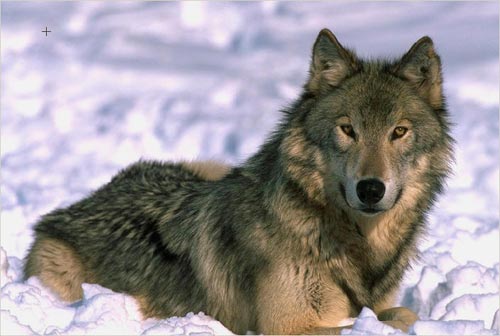
The wolf is the largest member of the canine family.
Wolves were once common throughout all of North America but were killed in most areas of the United States by the mid 1930s.Today their range has been reduced rapidly which cause many to be considered endangered. Loss of habitat and persecution by Humans are leading factors in the Wolves "Endangered Species Status".There are an estimated 7,000 to 11,200 wolves in Alaska and more than 5,000 in the lower 48 states.
Red WolfRed Wolves are only one of two species of wolves in the world. In 1973 they were declared an endangered species and in 1980 the USFWS officially declared the Red Wolf extinct in the wild. However the USFWS captured 17 red wolves prior to 1980 and has used an extensive breading program in over 38 zoos and nature centers around the US. They are called red wolves because of the reddish color of fur mostly behind their ears and along their legs and neck.Mexican WolfMexican wolves are the smallest subspecies of North American gray wolves. They are also the most endangered. Mexican wolves prefer to live in mountain forests, grasslands and shrublands, and are very social animals. They live in packs, which are complex social structures that include the breeding. Humans and habitat destruction pose the greatest threat to Mexican wolves. There are only about 200 Mexican wolves in captivity. The goal of the reintroduction program was to restore at least 100 wolves to the wild by 2008; unfortunately, at the end of 2008 there were only approximately 50. Arctic Wolf The arctic wolf preys on lemmings and arctic hare, but its most substantial source of food is musk oxen and caribou. Because of the scarcity of grazing plants, animals must roam a large area in order to find enough food to survive.The shoulder height of the arctic wolf varies from 25 to 31 inches. On average, they are about 3 feet tall from head to toe Grey Wolf It is known as the largest wild member of the canine family. Designed to hunt for meat, the Grey Wolf spends most of its time roaming tirelessly in search of large prey. Capable of running about 35 to 40 miles per hour, the Grey Wolf’s paws provide support in the snow. Another significant fact is that the wolves are basically color blind, and their pups are born deaf and blind. They begin to see only after 9 to 12 days. With a fast growth rate, these pups' weight will increase nearly 30 times in their first four months. The Adverage Wolf-HEIGHT: 26-32 Inches-LENGTH: 4.5-6.5 feet from nose to tale -WEIGHT: 55-130 lbs -LIFE SPAN: 7-8 years but some are known to have lived 10 yearsor more *Keep in mind that the male is more likely to be bigger and live longer than the female since their tactics in the wildlife are based on survival

|
| Copyright 2011 - HOWL.org All wolf images used with permission from M/Y/D/S Animal graphics, Wolf Conservation Center, White Wolf Sanctuary, and California Wolf Center. |